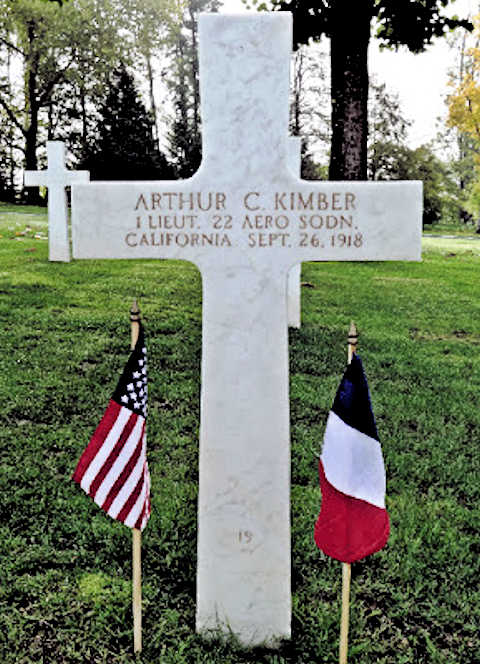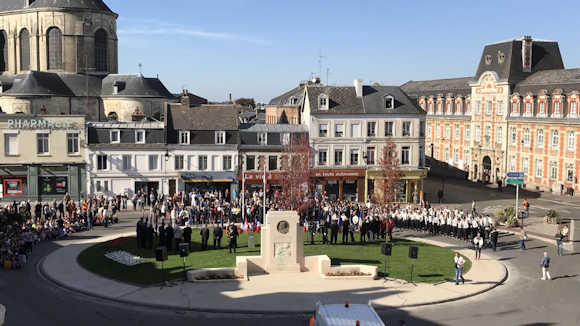A Depression-Era Story of
Mourning, Motherhood, and Grandiosity
By Lisa M. Budreau
On Memorial Day 1930, Mrs. Mathilda Burling of New York stood before the headstone of her son, Private George B. Burling, Jr, at grave 17, row 29, at the St. Mihiel American Cemetery in Thiaucourt, France. Burling, an imposing matriarch in a cloche hat and glasses, savored the realization that her decade-long struggle to persuade the government to ensure the right of Gold Star mothers to stand before the graves of their sons had indeed succeeded beyond all expectations. She had earned this sweet victory, but just five minutes later, she turned and walked away.
The journey to her son’s grave had been arduous. By the time the Armistice was signed in 1918, thousands of young American men had died in Europe. Shortly after U.S. entry into the Great War the Army announced that the dead would remain temporarily buried in Europe, until after hostilities ended, when bodies would then be repatriated. As the nation searched for a modern way to mourn the sacrifices from this unpopular foreign war, the ongoing plight of the mothers of the dead became a major political saga that dragged out for another decade.
The full story of the pilgrimage of these “Gold Star Mothers” to Europe in 1930 has its quirky, amusing elements, but it reveals an unsettled side to American’s celebration of Memorial Day—born out of long-standing ambivalence about involvement in foreign wars, confusion about how to honor the dead, and a vexed desire to turn grief into glory.
Almost from the Armistice, organized groups of mothers pleaded for subsidized cemetery visits to Europe. By 1928 they had become pros at political maneuvering and social reform, agitation and publicity, initiating bipartisan appeals to legislators through massive letter-writing campaigns, and the manipulation of public opinion. Central to the lobbying effort was a group called the Gold Star Mothers, women named for the gold stars they wore on armbands and service flags in their homes. They were accorded greater recognition from society for having lost loved ones in war.
At last, in 1928, after numerous failed attempts, the legislation to pay for the Gold Star pilgrimages was put before Congress. While several Gold Star Mothers testified, the most aggressive rhetoric came from Mathilda Burling, who was generally known as pushy and presumptuous. While some women despised Burling’s methods, others were quick to praise her as the woman who had worked day and night for this bill. A self-promoter of the highest order, Burling claimed to have conceived the idea of the pilgrimage while simultaneously taking credit for organizing the original Gold Star Association—both untrue.
During the congressional hearing Burling did not hesitate to make jarring assertions like, “Our boys were murdered, they were not given a fair chance to fight in a patriotic way.” Generally, her commentary simply exploited patriotic motherhood ideals with unblushing forthrightness. “As a mother whose only child lies over there, and who is authorized to represent the Gold Star Mothers of America,” she began, “I can not believe that the Senate of my country will deny us the privilege of paying a visit to those holy graves of our heroic sons abroad.”
Burling’s impassioned claims were overzealous at best, but she spoke to something real—the country’s unfinished grief over the war dead. “Eleven long years have passed since my boy, who was only a child in years, gave his life for the defense of this country,” she said. “Each year I have lived in the hope that I would kneel before his grave.” Then, using maternalism to its fullest advantage, she wept while insisting that mothers had sacrificed more than widows. “It was our flesh and blood that enriched the foreign soil. After all, it was the mothers who had won the war.” On 2 March 2 1929, the notoriously frugal President Calvin Coolidge finally signed the pilgrimage legislation.
It was the job of the Army’s Quartermaster Corps, under the auspices of the War Department, to make all arrangements for nearly 7,000 women to travel to Europe in relatively luxurious accommodations between 1930 and 1933. At the height of the Depression, a team of professional officers managed the visits, ensuring the highest quality experience for all. Some mothers had never experienced hot and cold running water before reaching their hotel rooms. However, in keeping with Jim Crow era mores, black mothers traveled on separate ships and experienced less than equal accommodation.
Before setting sail, escorting officers were reminded that they had been selected for their superior judgment, common sense, and tact, but most of all, for their sobriety. Among the chosen was Lieutenant Colonel Stephen W. Winfree, an old-school cavalry officer with a preference for civilian attire, an eye for young women, and a thirst for highballs. Despite all their precautions, neither he nor the War Department was sufficiently prepared for mechanical failures and the late enrollment of one Mathilda Burling.
 |
Mrs. Burling
(Sadly, the Editor was not able to locate a photo of Col. Winfree, in or out of uniform) |
Burling’s son George had died of disease in 1918, while serving with the 53rd Coast Artillery Corps, but she decided to join the mothers and veterans’ reunion tour of the more illustrious 27th Division departing on 13 May. Though she was originally scheduled to travel with her own group, this unorthodox change—at the very last minute— would put her in France for the Memorial Day ceremonies. The 27th Division was one of only two American military units to serve with the British during the Great War. Burling could not help but be lured by the full itinerary, which included London, Brussels, and Paris and of course more excitement and media attention.
But just as the reunion voyage prepared to sail out of New York Harbor, an accident aboard another vessel required more Gold Star pilgrims to relocate onto the SS Republic with the women and veterans of the 27th Division. All were asked to share cabin space. It was not long before bickering began aboard the crowded ship with many questioning the presence of the overbearing Burling. The group would be known hereafter by the military organizers as “Party B.”
Colonel Winfree freely admitted that he was in the habit of handling horses and men, not women, but he must have had more serious concerns after being warned that the trip could be troublesome and that Mrs. Burling was a “woman politician” who could be a “nuisance.” There was friction as Party B traveled from France to England and Belgium. Still, he could not have gauged the extent of trouble awaiting him when Burling and a fellow passenger found Winfree enjoying himself with a young lady friend at the hotel bar one night just before the ship’s return to the U.S.
When Burling asked the colonel why he was not wearing his uniform, he replied sarcastically, “What do you want me to do, wear the uniform and look like a porter and carry the mothers’ pocketbooks and handbags?” An argument followed and Winfree, who had clearly had more than a few drinks, insisted that the older women be a “sport” and join the party, according to transcripts of Burling’s later testimony. Then Winfree yelled, “I’d give anything to take you out one night and get you tight, too; come on, have a highball. You are a little virgin, a little white lily; I’d like to get you tight just to see what you would do.” As an afterthought, he added, “And, further, I don’t even know whether you have a boy over here or not!”
Within weeks of the group’s return to the United States, Winfree was forced to defend himself in a military investigation. Burling’s testimony was devastating for the colonel, who was relieved of duty that summer. In his defense, the outspoken cavalry officer had voiced what some in the military had previously only dared to allude to in their private memoranda. Theirs was an organization in crisis, an army in limbo, subjected to relentless fiscal cuts, which meant under-staffing and slow promotions. It was said that military units had to beg outside local sources for office supplies and even the daily ration of toilet paper was limited to three sheets for each soldier. Yet, while the military struggled, the indulgences and approbation shown the Gold Star Mothers were flaunted before the nation.
Winfree denied all charges against him but in doing so, ultimately exposed Burling’s greatest weakness—her “motherhood.” He told investigators that when at last she reached St. Mihiel American Cemetery, the aim of her life’s work, Burling stood less than five minutes before the grave of her son because she was eager to attend a reception at another cemetery. She became indignant at Winfree’s refusal to allow her to leave for what promised to be a more high-profile event. With hostility and impatience, Burling informed Winfree that this grave was, after all, only that of her stepson.
 |
| Party B Ready to Depart |
Mathilda Burling, whose political abilities had previously helped bring the pilgrimage legislation to fruition, was, by unanimous vote, dropped from Gold Star Mothers membership for “disloyalty” in 1931, still owing two years’ back membership dues.
[Editor's Note:] Mathilda must have made a comeback of sorts. In searching for photos, I found later images of her laying a wreath at the Tomb of the Unknown Soldier and shaking President Harry Truman's hand in 1947. She must have caught up on her dues.]
Source: From the Smithsonian and Arizona State University Series "What It Means to Be an American."













































